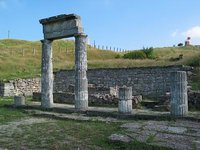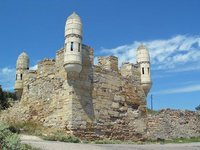Kerch
|
|
Kerch (in Russian Керчь; in Ukrainian Керч; in Turkish and Crimean Tatar Kerç) is a city (2001 pop 157,000) on the Kerch Peninsula of eastern Crimea, an important industrial, transportation and tourist centre of Ukraine. The name comes from Turkic ’kirech’ which means lime.
| |||
|
Missing image | |||
| State | Ukraine | ||
| Region | Republic of Crimea | ||
| Geographical coordinates | Template:Coor dm | ||
| Founded | 7th century BC | ||
| Population | 157,000 (2001) | ||
| Languages | Russian, Ukrainian | ||
| Gorodskoy Golova (Mayor) | Oleg Osadchiy (2004) | ||
| Phone prefix | 06561 | ||
| Time zone | GMT + 2:00 (Kiev Time) | ||
| Contents |
History
Ancient times
Kerch is one of the most ancient cities of the world, archeological digs at Mayak village near the city ascertained that the area had already been inhabited in 17th–15th centuries BC.
Kerch as a city starts its history in 7th century BC, when Greek colonists from Miletus founded a city-state named Panticapaeum (which means fish road) on the shore of Kerch Strait. Panticapaeum was a predecessor of present-day Kerch city, it subdued nearby cities and by 480 BC became a capital of the Kingdom of Bosporus. The city located at the intersection of trade roads between Asia and Europe grew rapidly. The city's main exports were grain and salted fish, wine-making was also common. Panticapaeum minted its own coins.
In 1st century AD Panticapaeum and the Kingdom of Bosporus suffered from Ostrogoth raids, then the city was devastated by the Huns in AD 375.
Middle Ages
From the 6th century AD the city was under Byzantine control. By order of Emperor Justinian a citadel named Bospor was built there. Bospor was a center of diocese and developed under influence of Greek Christianity.
In the 7th century the Turkic Khazars took control of Bospor, and the city was named Karcha or Charsha. The main local government official during Khazar times was the tudun. Christianity was a major religion in Kerch during the period of Khazar rule. Kerch's Church of St. John the Baptist was founded in 717. The "Church of the Apostles" existed during the late 8th century and early 9th century, according to the "Life of the Apostle Andrew" by Epiphanus.
Following the fall of Khazaria to Kievian Rus' in the late 900s, Kerch became the center of a Khazar successor-state. Its ruler, Georgius Tzul, was deposed by a Byzantine-Rus expedition in 1016.
From the 10th century the city was a Slavic settlement named Korchev, which belonged to the Tmutarakan principality. Korchev was a center of trade between Rus, Crimea, Caucasus, and the Orient.
In the 13th century Crimea including Korchev was invaded by Tartars. After Tartars, the city became the Genoese colony of Cerco (Cherkio) in 1318 and served as a sea harbour, townspeople worked at salt-works and fishery.
In 1475 city was passed to the Ottoman Empire. During the Turkish rule Kerch fell into decay and served as a slave-market. It repeatedly suffered from raids of Zaporizhian Cossacks.
Modern times
In responce to strengthening of Russian military forces in Azov area, Turks built a fortress of Yenikale in 1706 near the city on the shore of Kerch Strait. In 1771 Russian Army invided into Crimea and by the Peace Treaty of Kuchuk-Kainarji in 1774, Kerch and Yenikale were ceded to Russia. As a result, the Turkish heritage has been almost completely wiped out. In 1790 Russian naval forces under the command of admiral Fyodor Ushakov defeated the Turkish fleet in warfare on Kerch Strait.
Because of its location, from 1821 Kerch developed into an important trade and fishing port. The state museum of ancient times and a number of educational institutions were opened in the city. The ironwork factory was built in 1846 based on a huge iron ore deposit found on Kerch Peninsula.
During the Crimean War the city was devastated by British forces in 1855.
In the late 19th century mechanical and cement factories were built, tinned food and tobacco factories were launched. By 1900 Kerch was connected to a railroad system, and the fairway of Kerch Strait was deepened and widened. Population had reached 33,000.
After suffering a decline during the First World War and the Russian Civil War, the city resumed its growth in the late 1920s with the expansion of various industries, iron ore and metallurgy in particular, and by 1939 its population had reached 104,500.
Kerch in World War II
During the Great Patriotic War of 1941 to 1945, Kerch was the site of heavy fighting between Soviet Army and Nazi forces. After fierce fighting, city was taken by the Germans in November 1941. On 30 December 1941 the Soviets recaptured the city in a naval landing operation. In 1942 the Germans occupied the city again. On 31 October 1943 another Soviet naval landing operation was launched. Kerch was finally liberated on 11 April 1944.
The German occupants killed about 15,000 citizens and deported another 14,000 during their reign. Evidence of German atrocities in Kerch was presented in the Nuremberg trials. After the War the city was awarded the title Hero City.
Ajimushkay catacombs (mines) in the city's suburbs were a site of heroic guerilla campaign against occupation. Thousands of soldiers and refugees found shelter inside, making permanent counterattacks. Many of them died underground as a result of German storm attempts (incl. those with chemical weapon) and hunger. Later a memorial was established on the site.
Modern Kerch
Industry
Today Kerch is considered as a city of metallurgists, shipbuilders and fishermen. The largest enterprises in the city are:
- Kerch Metallurgical Works Factory launched in 1900
- Kamysh-Burun Iron Ore Plant
- "Zaliv" ("Gulf") shipbuilding factory that produces supertankers and warships.
Construction-materials, food processing, and light industries play a significant role in the city's economy. Kerch is also a fishing fleet base and an important processing center for numerous fish products.
After the disintegration of Soviet Union hard times came for metal manufacture and shipbuilding in the city and Kerch is gradually turning into a resort and tourist centre.
Transport
Kerch has a harbour on the Kerch Strait, which makes it a key to the Sea of Azov, a railroad terminal and a small airport. Ferry transportation across the Kerch Strait was established in 1953, connecting the Crimea and the Krasnodar Krai (Port Krym - Port Kavkaz line). Bus network connects Kerch to other cities in Crimea and Krasnodar Krai.
Education
Kerch hosts (2004):
- 28 schools,
- 9 institutes and branches of Ukrainian and Russian universities,
- shipbuilding and polytechnical colleges,
- medical school,
- 6 PTU schools,
- a number of pre-school child institutions
Archaeology
Archaeological digs in Kerch has been launched in the middle of 19th century. Since then the site of ancient Panticapaeum city on Mount Mithradates has been systematically excavated. Located nearby are several ancient burial mounds (kurghans) and excavated cities. Kerch takes part in UNESCO's "Silk Road" programme.
Tourism
Because of its location on shores of Azov and Black seas, Kerch became a popular summer resort among people of former USSR. Also, several mud-cure sources are located near the city.
Kerch has a number of impressive architectural and historical monuments. Ancient historical heritage of the city makes it attractive for scientific tourism. The most notible of Kerch's sights are:
- Site of ancient settlement Pantikapaeum (5th century BC–3rd century AD)
- Tsarskiy Kurghan (4th century BC) - burial mound for one of Bosporian kings
- Church of St. John the Baptist (AD 717)
- Fortress of Yenikale (18th century)
- Large Mithradates Ladder leading on top of the Mount Mithradates, contains 428 footsteps, built in 1833–1840 under the guidance of Italian architect A. Digbi
- Obelisk of Glory on the Mount Mithradates, built after World War II
- Memorial of heroic guerilla warfare in Ajimushkay mines
External links
- Site of the city (in Russian) (http://www.kerch.com.ua)
- Webcam (http://www.kerch.com.ua/webcam/)de:Kertsch



